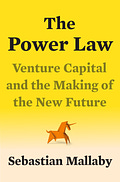📚: The Power Law: A History of Systematic Serendipity and Grand Slams
"Silicon Valley is gripped by the cult of the individual. But those individuals represent the triumph of the network." Matt Clifford
In 2002, a young hedge fund analyst was sifting through the rubble of the dotcom bust for ideas. After three years at Blackstone, Scott Shleifer had joined upstart Tiger Global, formed by Chase Coleman after his mentor Julian Robertson had shut down legendary Tiger Management at the peak of the bubble (see my thread).
In The Power Law, Sebastian Mallaby recounts how Shleifer dug through a list of technology stocks until he stumbled upon a group of Chinese internet companies. Sina, Sohu, and NetEase were not yet profitable but they were growing rapidly and their stock prices had imploded. When he started modeling their financials, trailing profit margins were of little use. Instead, he looked at incremental margins — how much of future revenue growth would fall to the bottom line.
Shleifer set up calls with management and threw out the idea that revenue growth would soon slow down. But the response was that online ads in China were just getting started, and costs would grow much more slowly than revenues. When Shleifer heard that he was the first Western investor to call in some time, his ears perked up. He continued his work and realized that within a few years these companies could be trading for as little as one or two times their profits.
He visited Coleman’s office with the words:
“Sina, Sohu, and NetEase. Let’s dance.”
By the summer of 2003, Tiger Global’s Chinese positions “were up between 5x and 10x.” This success led Shleifer and Coleman to visit China during the SARS epidemic and make their first venture investments.
They were not interested in emulating traditional venture capitalists who embedded themselves in local networks to find promising startups and original ideas. Rather, Tiger Global would take its hedge fund DNA and global view and bet on companies that emerged as winners in their respective categories and geographies. Coleman and Shleifer divided internet companies into segments such as “portals, online travel, and e-commerce,” Mallaby wrote. “The trick was to go country by country, identifying the firms that were emerging as the winners in each category.”
They were looking for a proven business model in an untapped new market such as “the eBay of South Korea” or “the Expedia of China.”
“The this of the that,” they called it. It was a powerful formula at the time and led to the birth of Tiger Global as a dominant crossover and growth investor (which just raised its latest $11 billion venture fund).




